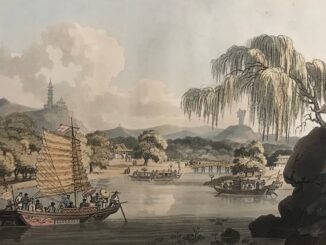Mark McKillion, Ulster University MA History graduate and volunteer for the Library in 2022, carried out research on Andrea Palladio’s I Quattro Libri dell’Architettura (1570) (object ID P001393207).
You can adopt this work for £500, and support the work of the Library, caring for our wonderful collections, and inspiring present and future generations!
Branko Mitrović introduces the works of the Italian Renaissance artist Andrea Palladio by highlighting his text I quattro libri dell’architettura, which he describes as one of the most influential architectural treatises ever written, as well as the culmination of Palladio taking inspiration from various scholars from his era who also specialised in architecture, including Vignola and Daniele Barbaro. Furthermore, Mitrović elaborates by noting how Palladio’s career was influenced by Barbaro, theorising that if the two architects had ever taken the opportunity to discuss architecture together, Palladio would have learned a substantial amount of Vitruvian terminology from the ‘latinissimo Barbaro,’ who in turn would find an important source of archaeological data in Palladio.[1]
Indeed, Palladio’s influence would extend to several future scholars, with Howard and Longair highlighting one of the most notable examples in the British art historian Rudolf Wittkower: in 1949, Wittkower would publish his text Architectural Principles in the Age of Humanism, in which he cites Palladio as an example of the historical significance of Renaissance architects, as well as the concept of ‘harmonic proportion’ that would have complemented the Pythagorean and Platonic theories of musical harmonies of that era.[2]
Howard and Longair continue by highlighting Palladio’s tendency to incorporate harmonic proportions in his own work, with one such example being the Villa Barbaro at Maser: in fact, this is the building that Wittkower has analysed in the most detail, stating that it provides a wide range of harmonic ratios, and theorises that its influence would result in Palladio making a conscious endeavour to design more harmonic buildings in his future projects following his collaborations with Barbaro.
Some examples of these harmonic buildings include the incomplete villas which he had designed for the Sarego family of Verona, as well as the palace project which he had designed for Giambattista della Torre, which bore a strong resemblance to the Sarego villa at Miega. Interestingly, Howard and Longair also note that two of Palladio’s patrons, Giacomo Angarano and Odoardo Thiene, were both noted for their radical Lutheran religious views, which would have been unusual for the period, especially since the first two books of the Quattro libtri were dedicated to Angarano in particular. This suggests that Angarano was very likely to have held an interest in architecture himself, and therefore he may have influenced Palladio as much as a dedicated architect such as Barbaro would have to the extent that he would be acknowledged for his contributions to the Quattro libri.[3]




